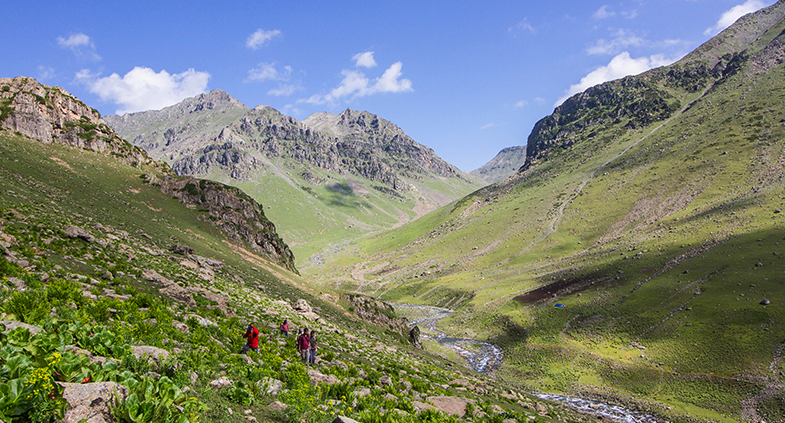Introduction
The exquisite beauty of Kashmir is undoubtedly impressive, which infatuates nature lovers, poets, and tourists. The Tarsar Marsar trek, state’s landscape is adorned with snow-covered mountains, fast-flowing rivers, velvety green meadows, alpine forests, beautiful alpine lakes, and whatnot. Thus truly, Kashmir deserves the title of “Heaven on Earth”.
Keeping aside the natural beauty, Kashmir is also the place of several famous Himalayan trails. Among which the Tarsar Marsar trek is one of them. The trail one follows on the Tarsar Marsar lake trek is unbelievably beautiful.
Tarsar Lake and Marsar Lake are two alpine lakes located at the height of 12500ft. And 13000ft respectively in the Kashmir Himalayas. These two lakes are of similar nature and are separated by a mountain and that is why they are called twin sisters.
Tarsar Marsar is located around 20 km to the east of Kolahoi Mountain in the Anantnag district of Jammu & Kashmir. Marsar Lake is specifically in the surrounding area of Dachigam national park.
Best Time to Visit
Being the most stunning trek of the Indian Himalayas, the best time to do Tarsar Masar Trek is from June to mid-September. Peak Sumer season is the ideal time to explore this part of the Himalayas. During the beginning of June, the temperature remains cold and the landscape above 3000 meters is partially covered with snow. The meadows get in their bloom and snow can be found in the gullies and mountain peaks during July. The weather gets dry in the month of August and fewer chances of rain are experienced when compared to June and July. The weather remains fully dry during September and also there is no conjunction on the path. So the best time to visit Tarsar Marsar Lakes is from the beginning of June to the end of September and it is also permissible by the department of Tourism Kashmir (UT) for the said season.
Weather details
The weather gets harsh and the meadows turn brown and cold winds from Dras make the region freezing in the month of October. As per the protocols of the Tourism Department, the trek is thus permitted from June to September only. Mountain Expeditions can also take place in the area by permission of IMF and UT Tourism Authorities during peak summer time only. The best time to traverse the alpine lakes of Kashmir is peak summertime only.
The journey begins at Srinagar. On the way to Aru, the best view to be enjoyed is the apple orchards and alpine trees. Aru is a picturesque hamlet located at the banks of the Lidder river at 7959 ft altitude where trekkers can spend the first night of their trip.
Route and location
Start an easy 10 km long ascent following the upstream of Lidder river the next day. One has to trek for 6 hours on this day. After crossing some local Gujjar settlements and two freshwater creeks, trekkers step into Lidderwat valley. The enchanting birds-eye view of Aru valley and Aru village will motivate the trekkers to proceed further. The journey for this day will be completed by camping at Lidderwat valley.
The journey of 5.5 Km begins from the meadow of Lidderwat and ends at the valley of Shekwas. It generally takes 5 hrs on the third day.
The trail follows the Lidder river from Lidderwat valley and enters a pine forest. A wooden bridge will take trekkers to the other side of the Lidder river and after half an hour hiking along the river, trekkers will reach Homwas, a small dell.
The path is straight right after Homwasand comfortable but not for so long. Trek a steep ascent afterward through a forest of Bhoj trees and some more valleys and clear one to step into Shekwas, another meadow at 11000 ft where trekkers spend the night in a tent.
Trek from Shekwas to Tarsar lake on the fourth day. The trail makes trekkers cross several ridges on mountain streams. After steep climbing and trekking for two hours, they will get the first glimpse of the beautiful almond-shaped Tarsar lake. The site enlivens the beholder to reach the lake as quickly as possible. Trek to Tarsar lake at 12500ft height takes almost 3 to 4 hours to complete and covers a 5 km distance on this day.
Conclusion
Trekkers will witness surpassing beauty on their way from Tarsar to Sundersar lake on the fifth day. This trek starts from Tarsar valley and heads towards Shekwas valley. Following the streams and shepherd’s trail, one will pass through lush green grasslands leaving behind Bakharwal Thatch.
The next day’s destination is Marsar lake from Sundersar valley. This demands covering 9 km in 7 hours. Marsar Lake is visible only after climbing to the ridges.
Towards the end of the trip, head back to Homwas through Jagmargi valley, trekking 13 km in 6 hrs on the last day of the trek.
Since the Tarsar Marsar trek is a relatively easy trek to explore and since it has so much to offer, there is no other reason why it should not be on the bucket list of treks to do. In fact, it should be the first trek to do on any trekking bucket list!

